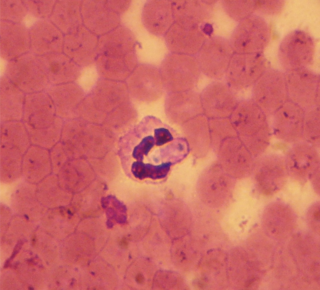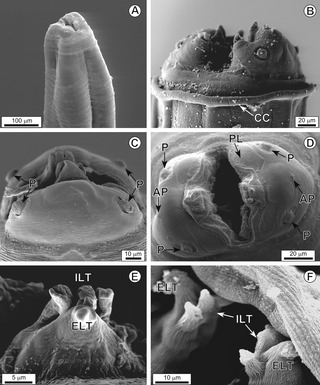
Hepatozoon is a genus of Apicomplexa alveolates which incorporates over 300 species of obligate intraerythrocytic parasites. Species have been described from all groups of tetrapod vertebrates, as well as a wide range of haematophagous arthropods, which serve as both the vectors and definitive hosts of the parasite. By far the most biodiverse and prevalent of all haemogregarines, the genus is distinguished by its unique reciprocal trophic lifecycle which lacks the salivary transmission between hosts commonly associated with other apicomplexans. While particularly prevalent in amphibians and reptiles, the genus is more well known in veterinary circles for causing a tick-borne disease called hepatozoonosis in some mammals.

The white-headed marmoset, also known as the tufted-ear marmoset, Geoffroy's marmoset, or Geoffrey's marmoset, is a marmoset endemic to forests in eastern Brazil, where it is native to Bahia, Espírito Santo, and Minas Gerais, and introduced to Santa Catarina. It is known as the sagüi or sauim in Brazil. Its diet consists of fruits, insects, and the gum of trees. It is a host of Pachysentis lenti an acanthocephalan intestinal parasite.

Viviennea is a genus of moths in the family Erebidae. The genus was described by Watson in 1975.

Oligacanthorhynchida is an order containing a single parasitic worm family, Oligacanthorhynchidae, that attach themselves to the intestinal wall of terrestrial vertebrates.
Centrorhynchidae is a family of parasitic worms. Three species of these thorny-headed worms in the genus Centrorhynchus were found to parasitize birds of prey and owls Slovakia. These hosts include Buteo buteo, Buteo rufinus, Falco tinnunculus, Asio otus, Strix aluco, Strix uralensis and Tyto alba.

The Noronha skink is a species of skink from the island of Fernando de Noronha off northeastern Brazil. It is covered with dark and light spots on the upperparts and is usually about 7 to 10 cm in length. The tail is long and muscular, but breaks off easily. Very common throughout Fernando de Noronha, it is an opportunistic feeder, eating both insects and plant material, including nectar from the Erythrina velutina tree, as well as other material ranging from cookie crumbs to eggs of its own species. Introduced predators such as feral cats prey on it and several parasitic worms infect it.
Ascocotyle pindoramensis is a fluke in the genus Ascocotyle that occurs along the eastern coast of the Americas from Brazil to Nicaragua, Mexico, Louisiana, and Florida and doubtfully in Egypt. It occurs in the intestine of its definitive hosts. Hosts recorded in the wild include the least bittern, roseate spoonbill, great blue heron, striated heron, stripe-backed bittern, yellow-crowned night heron, black-crowned night heron, osprey, Neotropic cormorant, and marsh rice rat. In the marsh rice rat, it infected 9% of rats examined in a 1970–1972 study in the salt marsh at Cedar Key, Florida, but none in a freshwater marsh. A. pindoramensis has been experimentally introduced into the domestic duck, chicken, dog, house mouse, and golden hamster. It occurs in various body parts of its intermediate hosts—the poeciliid fish Phalloptychus januarius, Poecilia catemaconis, Poecilia mexicana, Poecilia mollienisicola, Poecilia vivipara, and a species of Xiphophorus and the cichlid Tilapia. It was first described as Pygidiopsis pindoramensis in 1928 and subsequently as Pseudoascocotyle mollienisicola in 1960. The latter species was moved to Ascocotyle in 1963, but only in 2006 it was recognized that the two represent the same species, which is now known as Ascocotyle pindoramensis. Other flukes from Argentina and Mexico that were identified as Pygidiopsis pindoramensis instead represent a different species of Pygidiopsis.
Maritrema is a genus of trematodes (flukes) in the family Microphallidae, although some have suggested its placement in the separate family Maritrematidae. It was first described by Nikoll in 1907 from birds in Britain. Species of the genus usually infect birds, but several have switched hosts and are found in mammals, such as the marsh rice rat. Several species use the fiddler crab Uca pugilator as an intermediate host.

Characidium is a genus of fish in the family Crenuchidae. They are mainly found in South America, but C. marshi is from Panama. They are small, slender fish that live on the bottom in flowing fresh waters and feed on small animals such as insects.

Echinostomatidae is a family of trematodes in the order Plagiorchiida, first described in 1899.
Traklosia is a genus of nematodes. The genus was originally circumscribed in 1961 under the name Robertia; L. Travassos and G. R. Kloss created this genus for their newly-described species R. leiperi. The nomen novum, Traklosia, was created for this genus in 2015 — Robertia was an invalid name due to a senior homonym. It consists of three species found in Brazil and Cuba, and they are parasites of millipedes.

Physalopteridae is a family of spirurian nematodes, which belongs to the superfamily Physalopteroidea. Like all nematodes, they have neither a circulatory nor a respiratory system.
Lueheia is a genus of worms belonging to the family Plagiorhynchidae.
Syphacia is a genus of nematodes belonging to the family Oxyuridae.
Philometroides is a genus of nematodes belonging to the family Philometridae.
Spinitectus is a genus of nematodes belonging to the family Cystidicolidae.
Cystidicoloides is a genus of nematodes belonging to the family Cystidicolidae.
Platynosomum is a genus of flatworms belonging to the family Dicrocoeliidae.

Creptotrema is a genus of Trematoda belonging to the family Allocreadiidae.

Echinostomatinae is a subfamily of trematodes in the order Plagiorchiida, first described in 1899.








